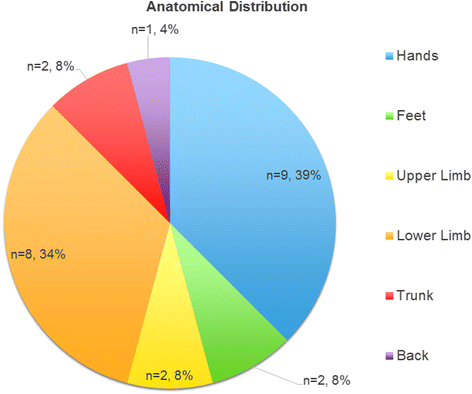Cold burn injuries in the UK: the 11-year experience of a tertiary burns centre
- PMID: 27843971
- PMCID: PMC5105282
- DOI: 10.1186/s41038-016-0060-x
Cold burn injuries in the UK: the 11-year experience of a tertiary burns centre
Abstract
Background: Guidance for the management of thermal injuries has evolved with improved understanding of burn pathophysiology. Guidance for the management of cold burn injuries is not widely available. The management of these burns differs from the standard management of thermal injuries. This study aimed to review the etiology and management of all cold burns presenting to a large regional burn centre in the UK and to provide a simplified management pathway for cold burns.
Methods: An 11-year retrospective analysis (1 January 2003-31 December 2014) of all cold injuries presenting to a regional burns centre in the UK was conducted. Patient case notes were reviewed for injury mechanism, first aid administered, treatment outcomes and time to healing. An anonymized nationwide survey on aspects of management of cold burns was disseminated between 13 July 2015-5 October 2015 to British Association of Plastic Reconstructive and Aesthetic Surgeons (BAPRAS) and Plastic Surgery Trainees Association (PLASTA) members in the UK. Electronic searches of MEDLINE, EMBASE and the Cochrane Library were performed to identify relevant literature to provide evidence for a management pathway for cold burn injuries.
Results: Twenty-three patients were identified. Age range was 8 months-69 years. Total body surface area (TBSA) burn ranged from 0.25 to 5 %. Twenty cases involved peripheral limbs. Seventeen (73.9 %)cases were accidental, with the remaining six (26.1 %) cases being deliberate self-inflicted injuries. Only eight patients received first aid. All except one patient were managed conservatively. One case required skin graft application due to delayed healing. We received 52 responses from a total of 200 questionaires. Ninety percent of responders think clearer guidelines should exist. We present a simplified management pathway based on evidence identified in our literature search.
Conclusions: Cold burns are uncommon in comparison to other types of burn injuries. In the UK, a disproportionate number of cold burn injuries are deliberately self-inflicted, especially in the younger patient population. Our findings reflect a gap in clinical knowledge and experience. We proposed a simplified management pathway for managing cold burn injuries, consisting of adequate first aid using warm water, oral prostaglandin inhibitors, deroofing of blisters and topical antithromboxane therapy.
Keywords: Cold burn; Guideline; Survey; Treatment.
Figures
Similar articles
-
E-cigarette burn injuries: Comprehensive review and management guidelines proposal.Burns. 2019 Jun;45(4):763-771. doi: 10.1016/j.burns.2018.09.015. Epub 2018 Nov 12. Burns. 2019. PMID: 30442380 Review.
-
Self-inflicted Burns: 10 year review and comparison to national guidelines.Burns. 2016 Feb;42(1):215-221. doi: 10.1016/j.burns.2015.09.018. Epub 2015 Oct 23. Burns. 2016. PMID: 26603912
-
Civilian blast-related burn injuries.Ann Burns Fire Disasters. 2016 Mar 31;29(1):43-46. Ann Burns Fire Disasters. 2016. PMID: 27857651 Free PMC article.
-
Cold burn injuries in the United Kingdom: retain-->A 5-year cohort study of patients presenting to a regional burn unit.J Plast Reconstr Aesthet Surg. 2024 Mar;90:315-322. doi: 10.1016/j.bjps.2024.01.007. Epub 2024 Feb 5. J Plast Reconstr Aesthet Surg. 2024. PMID: 38394839
-
Toxic shock syndrome in paediatric thermal injuries: A case series and systematic literature review.Burns. 2018 Feb;44(1):e1-e12. doi: 10.1016/j.burns.2017.07.002. Epub 2017 Sep 1. Burns. 2018. PMID: 28867411
Cited by
-
Non-Propellant Foams of Green Nano-Silver and Sulfadiazine: Development and In Vivo Evaluation for Burn Wounds.Pharm Res. 2019 Jun 19;36(8):122. doi: 10.1007/s11095-019-2658-8. Pharm Res. 2019. PMID: 31218556
-
An Unusual Case of Cold Burn Injury in a Tropical Country.J Plast Reconstr Surg. 2022 Dec 6;2(3):107-112. doi: 10.53045/jprs.2022-0027. eCollection 2023 Jul 27. J Plast Reconstr Surg. 2022. PMID: 40385080 Free PMC article.
-
Burn injury from filling balloons with nitrous oxide.BMJ Case Rep. 2021 Dec 1;14(12):e247077. doi: 10.1136/bcr-2021-247077. BMJ Case Rep. 2021. PMID: 34853051 Free PMC article.
References
-
- Guyatt G, Gutterman D, Baumann MH, Addrizzo-Harris D, Hylek EM, Phillips B, et al. Grading strength of recommendations and quality of evidence in clinical guidelines: report from an American College of Chest Physicians task force. CHEST J. 2006;129(1):174–181. doi: 10.1378/chest.129.1.174. - DOI - PubMed
-
- Cauchy E, Marsigny B, Allamel G, Verhellen R, Chetaille E. The value of technetium 99 scintigraphy in the prognosis of amputation in severe frostbite injuries of the extremities: a retrospective study of 92 severe frostbite injuries. J Hand Surg. 2000;25(5):969–978. doi: 10.1053/jhsu.2000.16357. - DOI - PubMed
-
- Gage A, Gage A. Frostbite. Compr Ther. 1981;7(9):25–30. - PubMed
-
- Bracker M. Environmental and thermal injury. Clin Sports Med. 1992;11(2):419–436. - PubMed
LinkOut - more resources
Full Text Sources
Other Literature Sources
Miscellaneous


